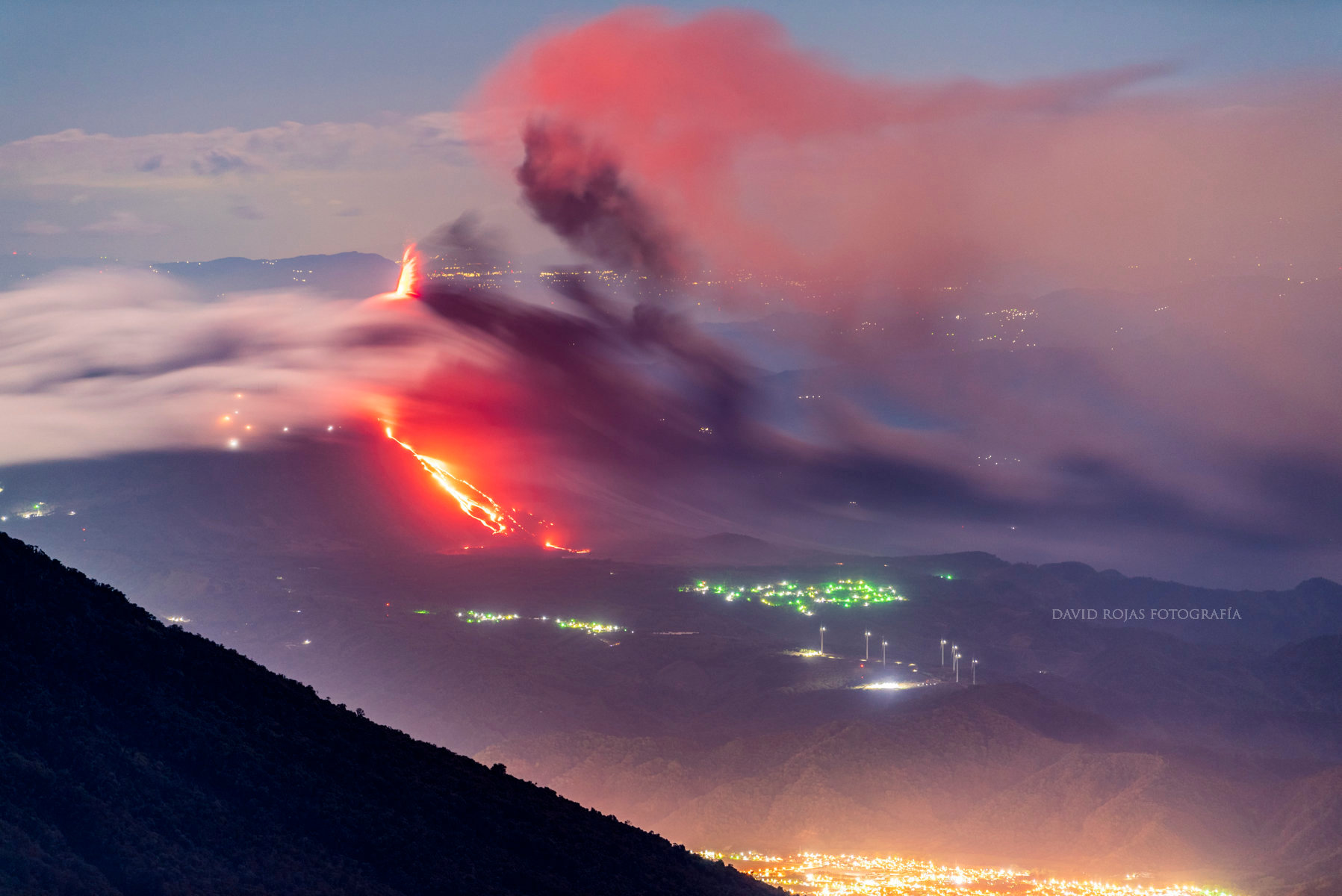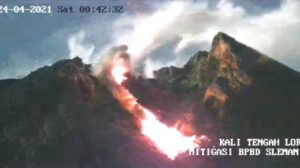 During the night 4 more pyroclastic flows erupted from the dome of Merapi volcano on Java. They produced seismic signals with a maximum amplitude of 55 mm and 161 seconds duration. The slip distance may have been around 1000 m. In addition, 82 debris avalanches were recorded within 6 hours.
During the night 4 more pyroclastic flows erupted from the dome of Merapi volcano on Java. They produced seismic signals with a maximum amplitude of 55 mm and 161 seconds duration. The slip distance may have been around 1000 m. In addition, 82 debris avalanches were recorded within 6 hours.
Eruptions
News about eruptions and volcanoes can be found in this category. It is updated frequently. Volcano expert and journalist Marc Szeglat reports live from his expeditions to volcanoes.
Pacaya: Pioneers build protective barrier
Date: 13.04.2021 | Location: 14.383°, -90.599° | Eruption: Vulcanian | Link
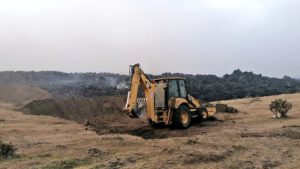 Eruption at Guatemala’s Pacaya volcano continues at high levels, with pulses of explosive eruptions from McKenney crater. Volcanic ash rises to 3500 m altitude and ash precipitation occurs. But the bigger problem is the lava flow that travels on the western flank of the volcano and has reached a length of 3700 meters. The lava flow is branching and moving onto farmland where coffee and avocado plantations are burning. The flow front is 400 meters from the first houses of the village of El Patrocinio and is advancing slowly. Another active front from the south is 250 meters east of the village of El Rodeo. A cooperative effort of sappers and civil defense has built a 175-meter-long dam, diverting portions of the lava flow. The terrain is hilly and the villages are protected by the topography. The question is, for how much longer?
Eruption at Guatemala’s Pacaya volcano continues at high levels, with pulses of explosive eruptions from McKenney crater. Volcanic ash rises to 3500 m altitude and ash precipitation occurs. But the bigger problem is the lava flow that travels on the western flank of the volcano and has reached a length of 3700 meters. The lava flow is branching and moving onto farmland where coffee and avocado plantations are burning. The flow front is 400 meters from the first houses of the village of El Patrocinio and is advancing slowly. Another active front from the south is 250 meters east of the village of El Rodeo. A cooperative effort of sappers and civil defense has built a 175-meter-long dam, diverting portions of the lava flow. The terrain is hilly and the villages are protected by the topography. The question is, for how much longer?
Fagradalsfjall: 4 new vents built
Date: 14.04.2021 | Location: 63.903, -22.273 | Eruption: Hawaiian| Link
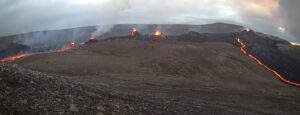 Yesterday, four more vents opened at Fagradalsfjall in Iceland. They manifested themselves in the already known area, between the first two vents and emitted comparatively much lava shortly after their formation, without any reduction of the production rate at the other vents. Thus, 2 lava streams flowed in different directions. In the meantime, the lava output has decreased again. The gas output doubled in the last days.
Yesterday, four more vents opened at Fagradalsfjall in Iceland. They manifested themselves in the already known area, between the first two vents and emitted comparatively much lava shortly after their formation, without any reduction of the production rate at the other vents. Thus, 2 lava streams flowed in different directions. In the meantime, the lava output has decreased again. The gas output doubled in the last days.
A total of 8 short fissures, or vents, have formed so far. On most of them hornitos were formed. More fissures may open above the magmatic vein at any time. GPS measurements show that the lava outflow outweighs the magma inflow from the depths and the area is subsiding.
The question of whether the eruption could develop into an eruption like the Laki eruption keeps popping up on social media. I think this is very unlikely, nevertheless the strength of the eruption can continue to fluctuate and nobody knows yet how long the natural spectacle will last. Comparable eruptions sometimes lasted for years.
Piton de la Fournaise: New eruption started
Date: 10.04.2021 | Location: -21.23, 55.717 | Eruption: Hawaiian| Link
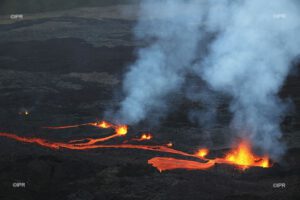 With so many volcanic eruptions, Piton de la Fournaise (La Réunion) of course cannot hold back any longer and joins the eruption round. On Friday evening, at 7 pm local time, an eruption fissure opened in the south of the caldera and the first eruption of the year began. Due to the Corona-related curfew, there were no pictures at first, but in the meantime photographers are on their way. It is a comparatively small eruption fissure of about 150 m length. Up to 20 m high lava fountains feed a lava flow. It has flowed a good 1.5 km so far. (Sources: IPR, OVPF)
With so many volcanic eruptions, Piton de la Fournaise (La Réunion) of course cannot hold back any longer and joins the eruption round. On Friday evening, at 7 pm local time, an eruption fissure opened in the south of the caldera and the first eruption of the year began. Due to the Corona-related curfew, there were no pictures at first, but in the meantime photographers are on their way. It is a comparatively small eruption fissure of about 150 m length. Up to 20 m high lava fountains feed a lava flow. It has flowed a good 1.5 km so far. (Sources: IPR, OVPF)
Soufrière: Explosive eruption on St. Vincent
Date: 09.04.2021 | Location: 13.34, -61.18 | Eruption: Pelanian
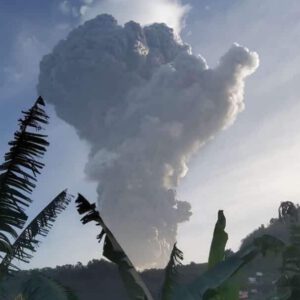 This morning, at 8.41 AM local time, the expected explosive eruption occurred at Soufrière volcano on St. Vincent. The Washington VAAC reports an ash cloud that is said to have risen to an altitude of 4000 meters. However, judging from images, the cloud penetrated to higher altitudes. According to media reports, the cloud reached a height of 6100 m. Shortly before the eruption, the alert level was raised from “orange” to “red”.
This morning, at 8.41 AM local time, the expected explosive eruption occurred at Soufrière volcano on St. Vincent. The Washington VAAC reports an ash cloud that is said to have risen to an altitude of 4000 meters. However, judging from images, the cloud penetrated to higher altitudes. According to media reports, the cloud reached a height of 6100 m. Shortly before the eruption, the alert level was raised from “orange” to “red”.
Evacuations were already ordered yesterday. The northern third of the Caribbean island is affected. In Georgetown alone, 1700 people must be brought to safety.
Soufrière: Evacuations initiated
Date: 08.04.2021 | Location: 13.34, -61.18 | Eruption: Lava dome | Link
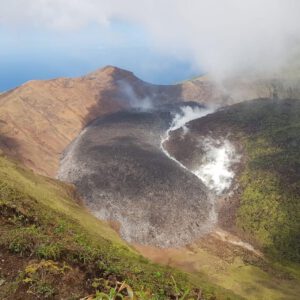 Evacuations have been initiated on the Caribbean island of St. Vincent. The reason for this is a significant increase in dome growth, which is accompanied by a significant increase in seismicity. Thus, 6 tremor episodes of increasing magnitude were reported yesterday. In addition, there were volcanotectonic tremors. The dome grew strongly and gained significant height. Moreover, it is not only fumarolically active, but has incandescent material on its surface. From the observatory, red glow could be observed over the crater at night.
Evacuations have been initiated on the Caribbean island of St. Vincent. The reason for this is a significant increase in dome growth, which is accompanied by a significant increase in seismicity. Thus, 6 tremor episodes of increasing magnitude were reported yesterday. In addition, there were volcanotectonic tremors. The dome grew strongly and gained significant height. Moreover, it is not only fumarolically active, but has incandescent material on its surface. From the observatory, red glow could be observed over the crater at night.
Pacaya: Lava flow increased
The situation at the Guatemalan volcano Pacaya continues to be tense: episodes of explosive eruptions occur, with volcanic ash rising to an altitude of 3000 m and being carried by the wind for about 20 km. Ash precipitation occurs in several localities. Incandescent tephra rises up to 225 m high. More worrisome is the lava flow traveling on the west side of the volcano. It originates from a fissure located relatively far down the outer flank of McKenney cone. The lava has already traveled a distance of 3000 m and destroyed some farm buildings. The lava front at the affected Campo Alegre farm stopped yesterday, but the front at La Breña reactivated. In fact, it is not excluded that the lava reaches the village of El Patrocinio, because the lava flow has been only about 300 m from the village.
Etna Paroxysm No 17
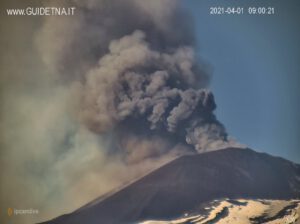 The 17th Etna paroxysm is occurring at Etna in Sicily this morning. The volcanic eruption is different from its predecessors this year. Already in the warm-up phase, a lava flow began to flow yesterday morning, originating from a production vent at the base of the New Southeast Crater Cone (NSEC). Earlier, explosive activity from the summit craters was already increasing. The tremor rose slowly and accelerated its increase in the evening hours. Since then it has been steadily increasing and in parallel the activity increased. Currently (9:15 a.m. CEST), an ash cloud is being produced. VAAC detects ash at 6700 m altitude. The wind is moving it in a southerly direction towards Catania. At night, glowing lava fountains were visible on LiveCams. There are 2 major lava flows. One pours directly from the NSEC and flows towards Valle del Bove. There the lava flow of yesterday finally lands. It makes a detour over the southeast.
The 17th Etna paroxysm is occurring at Etna in Sicily this morning. The volcanic eruption is different from its predecessors this year. Already in the warm-up phase, a lava flow began to flow yesterday morning, originating from a production vent at the base of the New Southeast Crater Cone (NSEC). Earlier, explosive activity from the summit craters was already increasing. The tremor rose slowly and accelerated its increase in the evening hours. Since then it has been steadily increasing and in parallel the activity increased. Currently (9:15 a.m. CEST), an ash cloud is being produced. VAAC detects ash at 6700 m altitude. The wind is moving it in a southerly direction towards Catania. At night, glowing lava fountains were visible on LiveCams. There are 2 major lava flows. One pours directly from the NSEC and flows towards Valle del Bove. There the lava flow of yesterday finally lands. It makes a detour over the southeast.
Fagradalsfjall: Volcanic eruption in Iceland continues
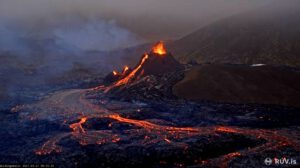 The volcanic eruption in Iceland, which began late in the evening of March 19, continues. According to the latest reports, at least 4 hornitos that formed on the short eruption fissure are still active at Fagradalsfjall. Lava spattering takes place from them and they feed lava flows that flood the bottom of the Geldingadali valley. Seismicity has continued to decrease sharply, yet IMO recorded 446 earthquakes in the last 48 hours. Two tremors had magnitudes above 3.
The volcanic eruption in Iceland, which began late in the evening of March 19, continues. According to the latest reports, at least 4 hornitos that formed on the short eruption fissure are still active at Fagradalsfjall. Lava spattering takes place from them and they feed lava flows that flood the bottom of the Geldingadali valley. Seismicity has continued to decrease sharply, yet IMO recorded 446 earthquakes in the last 48 hours. Two tremors had magnitudes above 3.
Pacaya: Activity level remains high
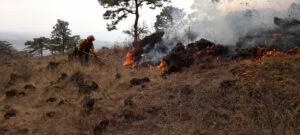 Pacaya in Guatemala continues to be very active, with repeated pulses of volcanic ash rising as high as 4300 meters. Lava flows are active in the south, emerging relatively far down the flank. MIROVA is registering high thermal radiation with 887 MW output. CONRED reported yesterday that a lava flow reached farmland and started fires. Firefighters had to move in to extinguish the burning grassland. Three homesteads were affected.
Pacaya in Guatemala continues to be very active, with repeated pulses of volcanic ash rising as high as 4300 meters. Lava flows are active in the south, emerging relatively far down the flank. MIROVA is registering high thermal radiation with 887 MW output. CONRED reported yesterday that a lava flow reached farmland and started fires. Firefighters had to move in to extinguish the burning grassland. Three homesteads were affected.
